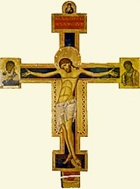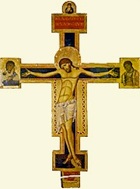Giunta Pisano (ca. 1180 - 1260)
Umbria: Home Cities History “Foreign” Painters in Umbria Hagiography Contact
Giunta Pisano in: Assisi


Giunta Pisano (ca. 1180 - 1260)
Umbria: Home Cities History “Foreign” Painters in Umbria Hagiography Contact
Giunta Pisano in: Assisi

Giunta Capitini da Pisa is known from three surviving painted crucifixes that bear his signature:
✴one from an unknown location is now in the Museo della Portiuncula, Assisi (illustrated above - see also below);
✴one from Sant’ Anna, Pisa is now in the Museo Nazionale di San Matteo, Pisa; and
✴one survives in its original location, San Domenico, Bologna.
A fourth, which Brother Elias commissioned in 1236 for San Francesco, Assisi no longer survives (see below).
All of these works represented the dying Christ in agony (Christus patiens), an iconography that was already established in Byzantine art, which superseded that of the triumphant Christ on the cross (Christus triumphans) in the west. Brother Elias had headed the new Franciscan mission to the Holy Land as Provincial Minister of Syria in 1217-20, and he may have introduced this Byzantine iconography to Italy. (See the page on St Francis and art).
Assisi
Christus Patiens (1236)
This crucifix, which was signed by Giunta Pisano and dated by inscription, is the only work of art that is known to have been in San Francesco before 1253. Giorgio Vasari, who saw it in the Upper Church in 1568, “on a beam that crosses the church”, did not see the inscription and attributed it to Margaritone d’ Arezzo.
Bishop Marcello Crescenzi was able to examine the crucifix in 1623, when it was moved from the beam to the counter-facade in preparation for the consecration of Francesco Boncompagni as Bishop of Fano. Fortunately, the letter that Bishop Crescenzi wrote about his discovery to Cardinal Federico Borromeo survives. He reported that he had found a tiny image of a friar kneeling at the foot of the cross, along with the inscription:
IESV CHRISTE PIE MISERERE PRECANTIS ELIAE
GIVNTA PISANVS ME PINXIT
ANNO D.M.CC. XXXVI . INDICTIONE NONA
Thus, the kneeling friar was Brother Elias, who had commissioned the work and who pleaded here for the mercy of Christ. (The Abbess Benedetta commissioned a similar crucifix (ca. 1260) from the Maestro di Santa Chiara for Santa Chiara, in which she was depicted at the foot of the Cross.)
It is interesting to note that Bishop Crescenzi said little else about the work of art itself: his main interest was in relation to the image of Brother Elias. In particular, his pointed hood confirmed the claim of the Capuchins that their distinctive “cappuccio”, the symbol of their return to the primitive observance, was indeed characteristic of the earliest Franciscan habit. It is interesting to note in this context that:
✴in 1627, Pope Urban VIII confirmed an earlier papal ruling that the Capuchins were the spiritual descendants of St Francis and not a mere offshoot of the Franciscan Order; and
✴an engraving (17th century) of the image of Brother Elias, which has been attributed to Francesco Providoni, was kept in the Capuchin convent of Santa Maria della Concezione, Rome until 1999, when it was stolen.
Unfortunately, the crucifix fell from the counter-facade and was shattered beyond repair in ca. 1700.
Christus Patiens (ca. 1236)

Read more:
E. Lunghi, “Il Crocefisso di Giunta Pisano e l' Icona del Maestro di San Francesco alla Porziuncola”, Assisi, (1995)
Return to Art in Assisi.
Return to “Foreign” Painters in Umbria.